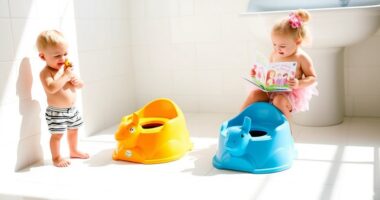When your toddler’s having a meltdown, staying calm is key. Acknowledge their feelings with phrases like, “It’s okay to feel sad.” Try redirecting their attention by counting objects or engaging them in sensory activities. Teach them deep breathing techniques—like “magic breaths”—to promote calmness. Giving them limited choices can also help reduce frustration. With these techniques, you can soothe their emotions quickly. Discover more effective strategies to handle meltdowns and foster emotional resilience.
Key Takeaways
- Stay calm yourself to model positive behavior and create a safe environment for the child.
- Validate the child’s feelings by acknowledging their emotions, saying, “It’s okay to feel sad.”
- Use distraction techniques, like counting objects or engaging in a sensory activity, to redirect their focus.
- Teach and practice deep breathing exercises together to promote immediate calmness and emotional regulation.
- Offer limited choices to empower the child and reduce frustration during a meltdown.

Toddler meltdowns can feel overwhelming, but with the right strategies, you can help your child navigate their emotions. When your toddler experiences a tantrum, it’s essential to stay calm. Your calmness not only sets a positive example but also helps your child feel safe and supported. Research shows that emotional intelligence plays a crucial role in developing strong coping mechanisms in children as they grow.
Start by validating their feelings; simply saying, “It’s okay to feel sad,” can work wonders in reducing the intensity of the meltdown. Acknowledging their big emotions allows them to understand that it’s normal to feel upset. Research indicates that emotional validation can significantly improve emotional regulation in children. Additionally, providing positive reinforcement during moments of calm can encourage better emotional behavior in the future.
Validating your toddler’s feelings, like saying “It’s okay to feel sad,” helps them understand that it’s normal to be upset.
Once you’ve validated their feelings, it’s time to redirect their focus. Use simple distraction techniques like counting objects around you or engaging in sensory activities. For instance, you could ask your child to count the number of toys in the room or touch different textures. This change in focus can help them move past their frustration and regain control over their emotions.
Incorporating deep breathing exercises can also be incredibly effective. Teach your toddler “magic breaths” by modeling the technique together in a calm environment. You can take a deep breath in, hold it for a moment, and then let it out slowly. Encourage your child to join you, and soon enough, they’ll associate deep breathing with calming down. Practicing this regularly can greatly improve their mental health and equip them with a valuable tool for future meltdowns.
Providing limited choices can also empower your toddler and help reduce frustration during changes. For example, instead of saying, “Get dressed,” you can ask, “Do you want to wear the red shirt or the blue shirt?” This approach gives them a sense of control over their situation, making it easier for them to adjust.
Creating a self-soothing toolkit can further aid your child in managing their emotions. Include items like stress balls, calming visuals, or favorite stuffed animals that your toddler can turn to when they feel overwhelmed. This toolkit can become a comforting resource for them during difficult moments. Additionally, fostering an environment of unconditional love can greatly enhance your child’s emotional resilience and ability to cope with stress.
Frequently Asked Questions
How to Calm Down a Toddler Meltdown?
When you’re faced with a toddler meltdown, start by acknowledging their feelings. Say something like, “It’s okay to feel sad.”
Then, try distracting them with a game or counting objects to shift their focus. Offering limited choices can help them feel in control; ask if they want the red or blue shirt.
Don’t forget to model deep breathing techniques. Show them how to breathe calmly, making it a fun practice they can easily follow.
How Do You Snap a Toddler Out of a Meltdown?
When your toddler’s emotions erupt like a volcano, it’s time to spring into action!
You can snap them out of that meltdown by redirecting their focus. Try counting colorful toys or spotting shapes around you. Offer them choices, like picking between two snacks, to empower them.
Acknowledge their feelings—let them know it’s okay to be upset.
Finally, introducing a fun activity or sensory tool can whisk them away from their distress!
How Do You Calm a Hysterical Toddler?
To calm a hysterical toddler, start by acknowledging their feelings. Say something like, “It’s okay to feel upset.”
Then, try distracting them with a fun activity, like counting toys or doing a quick sensory game. You can also encourage deep breathing together, guiding them through “magic breaths.”
If they’re still struggling, gently lead them to a self-regulation corner filled with calming tools. This approach helps them feel supported and regain control of their emotions.
How Do You Stop a Temper Tantrum in Seconds?
Imagine a stormy sea, waves crashing and winds howling. To calm that tempest, you’ve got to redirect the ship.
First, engage your child’s thinking brain by counting or identifying colors. Then, distract them with a game or activity, like a treasure hunt.
Introduce deep breaths, like magic gusts soothing the storm. Offer choices, empowering them to steer their own ship.
With these techniques, you can quickly navigate through the tantrum’s stormy waters.
Conclusion
When meltdowns happen, remember it’s just your toddler’s way of expressing big feelings in a little body. Instead of seeing it as chaos, think of it as a moment for connection and understanding. By embracing their emotions and offering a gentle hand, you’re not just calming the storm; you’re teaching them how to navigate life’s ups and downs. With a little patience and love, you’ll transform those turbulent moments into opportunities for growth and bonding.









